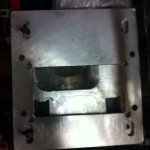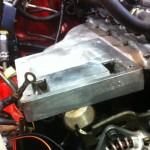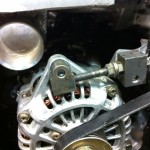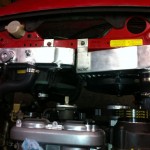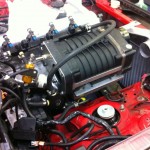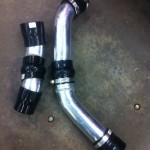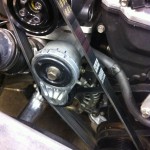![10450276_628275863068_9111196888486650278_o[1]](http://www.directedconsulting.com/destinationssm/wp-content/uploads/2014/11/10450276_628275863068_9111196888486650278_o1-150x150.jpg) My last post was full of optimism for a serious attempt at a season of autocross with the car. Unfortunately, the reliability gods decided against that. Over the course of the season, pretty much everything in the engine bay caused some sort of problem. The season started with the supercharger breaking at the Crow’s Landing Prosolo before I could even take any runs, then taking way too long to get fixed because, as always, vendors suck at keeping to their promises. That caused me to get it back on a Thursday night, throw it frantically into the car (the night before the Packwood Pro), where, during practice runs, the car showered its engine bay down with oil when something else failed. Later that event, the upper ball joints broke out of their press fits, requiring frantic tearing apart of the car between run groups to get them welded back in. It’s just been a year of a series of unfortunate events everywhere I tried to take the car. In the end, after considering the option of towing my car out to nationals, I instead just went to nationals in Ron Bauer’s DP car after almost bailing on the event altogether for the first time since I started.
My last post was full of optimism for a serious attempt at a season of autocross with the car. Unfortunately, the reliability gods decided against that. Over the course of the season, pretty much everything in the engine bay caused some sort of problem. The season started with the supercharger breaking at the Crow’s Landing Prosolo before I could even take any runs, then taking way too long to get fixed because, as always, vendors suck at keeping to their promises. That caused me to get it back on a Thursday night, throw it frantically into the car (the night before the Packwood Pro), where, during practice runs, the car showered its engine bay down with oil when something else failed. Later that event, the upper ball joints broke out of their press fits, requiring frantic tearing apart of the car between run groups to get them welded back in. It’s just been a year of a series of unfortunate events everywhere I tried to take the car. In the end, after considering the option of towing my car out to nationals, I instead just went to nationals in Ron Bauer’s DP car after almost bailing on the event altogether for the first time since I started.
![10172764_623243607748_4414811543945212468_n[1]](http://www.directedconsulting.com/destinationssm/wp-content/uploads/2014/11/10172764_623243607748_4414811543945212468_n1-150x150.jpg) This April, despite the Miata seeming to be in okay shape, I enacted phase 1 of my SSM contingency plan and picked up an Elise from New York and drove it back across the country to Seattle. The plan was to daily drive the car (I had been dailying our Forester for a while and was getting bored of that for some reason) and slowly just mod it into a fun and fast street car. I also knew that, in the end, it was probably a better platform for SSM than the Miata, and that it would likely someday take over, but I was thinking it’d be a couple years before that plan started unfolding. I was wrong.
This April, despite the Miata seeming to be in okay shape, I enacted phase 1 of my SSM contingency plan and picked up an Elise from New York and drove it back across the country to Seattle. The plan was to daily drive the car (I had been dailying our Forester for a while and was getting bored of that for some reason) and slowly just mod it into a fun and fast street car. I also knew that, in the end, it was probably a better platform for SSM than the Miata, and that it would likely someday take over, but I was thinking it’d be a couple years before that plan started unfolding. I was wrong.
![10583987_636369762828_5461914175468102933_n[1]](http://www.directedconsulting.com/destinationssm/wp-content/uploads/2014/11/10583987_636369762828_5461914175468102933_n1-150x150.jpg) Shortly after the SC blew up at Crow’s Landing, I tentatively made the decision to move up the timetable for the Elise. The first step was that I wanted to make sure that I could actually kill two birds with one stone with the car. I wanted the true unicorn — the daily driveable SSM car, and not just “could” daily drive, actually “want to” daily drive. So, I decided that the first thing to do would be suspension/wheels/tires for the car, so that it was in basically full SSM stiffness trim and I could try that out before committing to the full build.
Shortly after the SC blew up at Crow’s Landing, I tentatively made the decision to move up the timetable for the Elise. The first step was that I wanted to make sure that I could actually kill two birds with one stone with the car. I wanted the true unicorn — the daily driveable SSM car, and not just “could” daily drive, actually “want to” daily drive. So, I decided that the first thing to do would be suspension/wheels/tires for the car, so that it was in basically full SSM stiffness trim and I could try that out before committing to the full build.
![10592827_636689142788_6586557377148567369_n[1]](http://www.directedconsulting.com/destinationssm/wp-content/uploads/2014/11/10592827_636689142788_6586557377148567369_n1-150x150.jpg) While researching how I wanted to do that, an opening came up in a local performance driving school (high speed exercises + instructed lapping of Pacific Raceway) that I’d wanted my wife to take for a while. I had the perfect excuse to throw some money at the car and test it out at the same time. After talking with Fred Zust at Blackwatch Racing, we hatched a plan to quickly ship me a bunch of parts and get the car together in time for the track day. Much to my surprise, everything showed up on time and I had time to actually get the car aligned and do some shakedown on the street before the event. Needless to say, the car was a blast on the track and worked great, despite being somewhat down on power (which I later verified on the dyno as ~15% down). I daily drove the car for a couple weeks and quickly decided that I was completely fine driving the car this stiff on the street.
While researching how I wanted to do that, an opening came up in a local performance driving school (high speed exercises + instructed lapping of Pacific Raceway) that I’d wanted my wife to take for a while. I had the perfect excuse to throw some money at the car and test it out at the same time. After talking with Fred Zust at Blackwatch Racing, we hatched a plan to quickly ship me a bunch of parts and get the car together in time for the track day. Much to my surprise, everything showed up on time and I had time to actually get the car aligned and do some shakedown on the street before the event. Needless to say, the car was a blast on the track and worked great, despite being somewhat down on power (which I later verified on the dyno as ~15% down). I daily drove the car for a couple weeks and quickly decided that I was completely fine driving the car this stiff on the street.
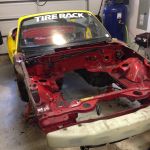 When the Miata had the several issues at the Packwood Pro, it was really the death knell, after I had already gone that deep into the Elise. In a local event right after nationals, I took the car out officially as the “last hurrah”, and, of course, to spite me, it immediately catastrophically broke again. It made it nice and easy to take the car home, roll it into the garage, throw it on jackstands, and immediately strip every sellable part from the carcass without remorse. Since then, I have been selling off the parts at a reasonable pace on all the major Miata boards.
When the Miata had the several issues at the Packwood Pro, it was really the death knell, after I had already gone that deep into the Elise. In a local event right after nationals, I took the car out officially as the “last hurrah”, and, of course, to spite me, it immediately catastrophically broke again. It made it nice and easy to take the car home, roll it into the garage, throw it on jackstands, and immediately strip every sellable part from the carcass without remorse. Since then, I have been selling off the parts at a reasonable pace on all the major Miata boards.
With money coming in from the Miata parts, at this point, I’ve paid for a good portion of the first phase of the build of the Elise. I hope to have everything together by the end of 2014 to have a winter/spring to work on the tune and really dial in the car to be ready for the season next year. I’ll be posting more detailing the build of the car as the more interesting parts start showing up and the motor comes out. The site will soon transform to only have history of the Miata on it and instead be focused on the Elise, so keep in touch.
